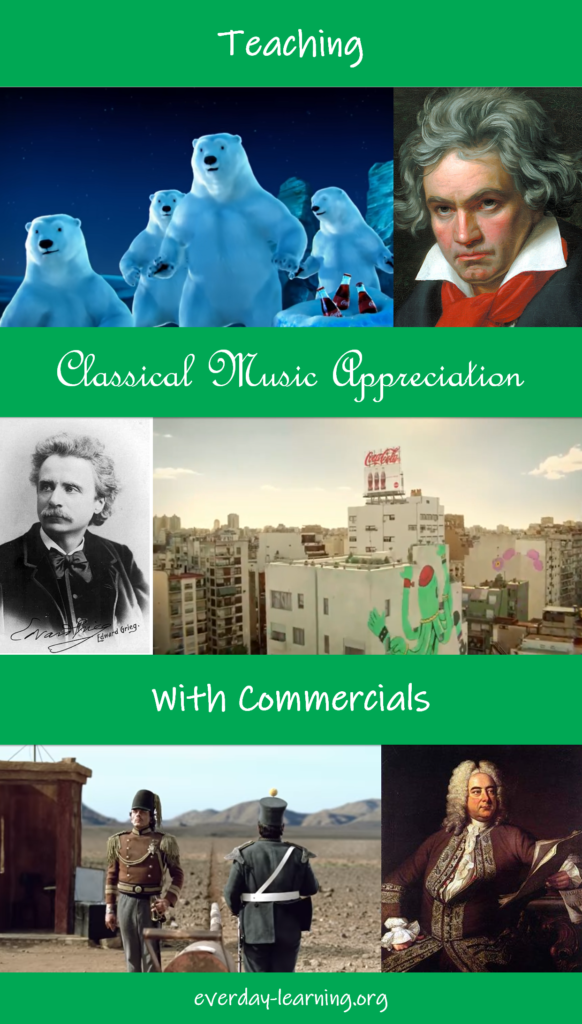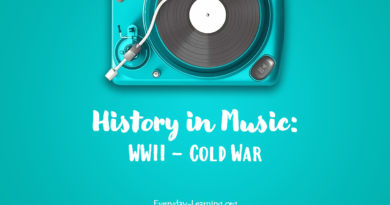Discover This: Classical Music

Homeschooling music can be intimidating for some families. If you’re like me, you can’t read music (despite years of trying) – you can’t sing on key – and, frankly, you can never remember the difference between a “melody” and a “harmony”. That doesn’t mean, however, you can’t teach music appreciation to your kids.
Classical music may seem stuffy to some people, but chances are you’ve heard way more of it than you ever realized. Clips of classical music have been used in movies and TV shows for ages. The music has also been used as stage intros for WWF wrestlers – opening credits for Judge Judy – and as background music in all kinds of video games.
And did I mention how commercials use classical music? You’ve got everything from the old Grey Poupon ads in the 1980s trying to exude the ultimate air of sophistication to a more recent Doritos ad that hilariously flips the script on a man trying to catch a mouse.
Exploring classical music through television commercials – with the purpose of building cultural arts literacy – can be fun. It requires nothing more than an internet connection and a chance to talk.
I’ve curated 7 Coca Cola advertisements that take you on a journey through 3 classical music time periods. (The first period, the Renaissance, which dates back to the 1400s, just doesn’t really lend itself to much commercial sampling.)
Here are some ideas on extending your classical music appreciation discussions:
- As you work your way through each piece, talk about the feelings the music evokes. Make a list of different adjectives and group them by time period. Do you see a pattern?
- How does the commercial’s storyline match up with the historical context of how and why the piece was written?
- If your kids are younger, encourage them to get up and move to the music themselves.
- If your kids are older, explore the allusions that may be embedded in the classical music commercial. For example, in the It’s Mine ad, look for the Peanuts cartoon character references and how does that add irony to the storyline?
- Can you identify any overarching themes across all the Coke commercials?
Keep reading and explore 7 hugely popular classical music pieces that have been used in Coca Cola advertisements throughout the years.
Baroque Period (1580 – 1750)
The Baroque Period was big on musical religious themes. Music from this period often contrasted loud and soft sounds, with sometimes sudden changes in volume. Composers began to use music as a form of communication. Opera developed during the Baroque Period as a distinct form of music.
Classical Music Commercial: Coca-Cola – Border Guards
Composer: Georg Friederich Handel
Music: Sarabande
Historical Context: A Sarabande was a fast-paced dance that orginated in Central America in the 1500s and made its way to Spain. Described as “a dance and song so loose in its words and so ugly in its motions that it is enough to excite bad emotions in even very decent people”, the Catholic Church banned the dance. The Sarabande, however, did not disappear. Composers, such as Handel, slowed the beat down and created more courtly versions that spread throughout Europe.
Classical Period (1730 – 1820)
As the Age of Enlightenment grew during the 18th century, so did music and art. Public concerts became a thing and more people, rather than just stuffy rich folks, could hear and appreciate the music being created at the time. As a result, classical music from the classical period, generally speaking, became simpler and more optimistic and upbeat sounding. The piano became the primary keyboard instrument. Comic operas became more popular.
Classical Music Commercial: Coca-Cola – Catch
Composer: Ludwig van Beethoven
Music: Symphony No. 5 – Allegro con brio
Historical Context: Beethoven took almost 4 years to write his 5th symphony – only to have it met with the most meh of critical responses when it was first performed in Vienna, Austria in 1808. This work, however, has gone on to become one of the most iconic pieces of classical music known. It is often thought of a bridge piece between the Classical and Romantic eras. About 30 years after the symphony was completed, Morse code was developed for use with the telegraph. Some people believe that the dot-dot-dot-dash code for the letter “V” references the opening notes of Beethoven’s symphony.
Modern Day Version: Walter Murphy’s A Fifth of Beethoven from the movie Saturday Night Fever
Romantic Period (1800 – 1910)
Revolutionary spirits gripped America and Europe during the early part of the Romantic Period. People rebelled against the old ways. The passionately dared to express themselves in new ways – politically and artistically. Music from this time brought new passion and emotion to the stage. The unpredictability and intensity of life was reflected in the use of irregular tempos within music.
Classical Music Commercial: Coca-Cola – Mural
Composer: Edvard Grieg
Music: In the Hall of the Mountain King from the Peer Gynt Suite
Historical Context: Commissioned to write music for fellow Scandinavian writer Henrik Ibsen, Grieg struggled to complete the task because, well, he didn’t like the assignment. After a couple of years of complaining and procrastinating, he finally finished the 90-minute orchestral composition. Later on, Grieg returned to the music and decided he really like a couple of the pieces. In the Hall of the Mountain King, as well as Morning Mood, have become some of the most recognizable classical music in the modern day.
Modern Day Version: Hair Up by Gwen Stefani and Justin Timberlake, featured in the movie Trolls – which is pretty funny since the original Peer Gynt story involves trolls.
Classical Music Commercial: Coca-Cola – It’s Mine
Composer: Gioachino Rossini
Music: Barber of Seville
Historical Context: Rossini, a prodigious Italian composer who wrote at least 2 operas a year for nearly 2 decades, completed his comic opera, The Barber of Seville, in 1816. Music historians believe he wrote this opera in less than 3 weeks. The opera tells the story of a rich young nobleman who disguises himself so a woman he is interested in will fall in love with him, not his money.
Classical Music Commercial: Coca-Cola – Siege Dragon
Composer: Pyotr Ilyich Tchaikovsky
Music: The Year 1812 Solemn Overture, Op. 49
Historical Context: In 1812, the French Army invaded Russia and went on to overtake the Russian capital. Unfortunately for Napoleon, Moscow burned to the ground and the French Army was completely unprepared to face their next formidable foe: The Russian winter. Napoleon’s army was ultimately decimated. More than 50 years later, the novel War and Peace was published praising the Russian resistance. Tchaikovsky was commissioned to write music commemorating the historical event. This piece has become standard music during many firework displays.
Modern Day Version: We Gonna Win by Miri Ben-Ari
Modern Period (1890 – 1975)
Think about how the impressionistic art of Claude Monet gave way to the Pablo Picasso’s surreal paintings at the turn of the 20th century. Keep that visual analogy in mind in order to understand music from the Modern Period. Although not quite an anything-goes approach, Modern classical music does reject much of the traditional structure found in the older periods of music.
Classical Music Commercial: Coca-Cola – Heist
Composer: Sergei Prokofiev
Music: Peter and the Wolf, Op. 67
Historical Context: In 1936, Russian composer Prokofiev was commissioned to write a narrated symphony that introduced children to individual instruments within an orchestra. Peter and the Wolf was written in less than a month. The story tells of a young boy who is warned to not wander in the woods alone, lest a wolf eat him. After the wolf eats the family’s duck, Peter catches the wolf. Rather than kill the wolf, he is taken to the local zoo.
Classical Music Commercial: Coca-Cola – Sleepwalker
Composer: Maurice Ravel
Music: Bolero
Historical Context: French composer Ravel was asked by a Russian dancer to compose a short ballet piece. Ravel was inspired by a Spanish dance called bolero. The entire piece lasts only 15 minutes, which is pretty short for a ballet. It was first performed in Paris in 1928, 10 years after World War I had ended. Bolero is one of Ravel’s last musical pieces before he retired due to a degenerative neurological problem that effected his memory, executive functioning abilities, and his ability to use words.
Modern Day Version: Generously sampled throughout Beck’s Bolero by Jeff Beck, along with Jimmy Page and Keith Moon (for you classic rock fans)




